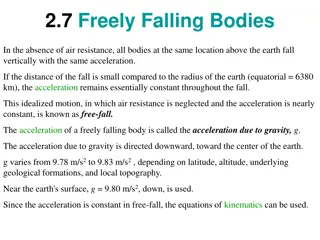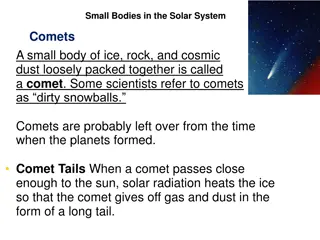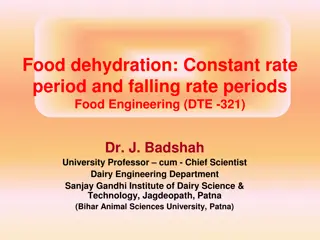Understanding Freely Falling Bodies
In the absence of air resistance, all bodies at the same location above the earth fall vertically with the same acceleration, whether thrown up or down. This idealized motion, known as free-fall, occurs when air resistance is neglected and the acceleration is nearly constant. The acceleration due to gravity, directed downward toward the center of the earth, remains essentially constant throughout the fall.
Uploaded on Oct 03, 2024 | 0 Views
Download Presentation

Please find below an Image/Link to download the presentation.
The content on the website is provided AS IS for your information and personal use only. It may not be sold, licensed, or shared on other websites without obtaining consent from the author. Download presentation by click this link. If you encounter any issues during the download, it is possible that the publisher has removed the file from their server.
E N D
Presentation Transcript
2.7 Freely Falling Bodies In the absence of air resistance, all bodies at the same location above the earth fall vertically with the same acceleration, whether they are thrown up or down.
2.7 Freely Falling Bodies In the absence of air resistance, all bodies at the same location above the earth fall vertically with the same acceleration, whether they are thrown up or down. If the distance of the fall is small compared to the radius of the earth (equatorial = 6380 km), the acceleration remains essentially constant throughout the fall.
2.7 Freely Falling Bodies In the absence of air resistance, all bodies at the same location above the earth fall vertically with the same acceleration, whether they are thrown up or down. If the distance of the fall is small compared to the radius of the earth (equatorial = 6380 km), the acceleration remains essentially constant throughout the fall. This idealized motion, in which air resistance is neglected and the acceleration is nearly constant, is known as free-fall. Object can move down or up.
2.7 Freely Falling Bodies In the absence of air resistance, all bodies at the same location above the earth fall vertically with the same acceleration, whether they are thrown up or down. If the distance of the fall is small compared to the radius of the earth (equatorial = 6380 km), the acceleration remains essentially constant throughout the fall. This idealized motion, in which air resistance is neglected and the acceleration is nearly constant, is known as free-fall. Object can move down or up. The acceleration of a freely falling body is called the acceleration due to gravity,g.
2.7 Freely Falling Bodies In the absence of air resistance, all bodies at the same location above the earth fall vertically with the same acceleration, whether they are thrown up or down. If the distance of the fall is small compared to the radius of the earth (equatorial = 6380 km), the acceleration remains essentially constant throughout the fall. This idealized motion, in which air resistance is neglected and the acceleration is nearly constant, is known as free-fall. Object can move down or up. The acceleration of a freely falling body is called the acceleration due to gravity,g. The acceleration due to gravity is directed downward, toward the center of the earth.
2.7 Freely Falling Bodies In the absence of air resistance, all bodies at the same location above the earth fall vertically with the same acceleration, whether they are thrown up or down. If the distance of the fall is small compared to the radius of the earth (equatorial = 6380 km), the acceleration remains essentially constant throughout the fall. This idealized motion, in which air resistance is neglected and the acceleration is nearly constant, is known as free-fall. Object can move down or up. The acceleration of a freely falling body is called the acceleration due to gravity,g. The acceleration due to gravity is directed downward, toward the center of the earth. g varies from 9.78 m/s2 to 9.83 m/s2 , depending on latitude, altitude, underlying geological formations, and local topography.
2.7 Freely Falling Bodies In the absence of air resistance, all bodies at the same location above the earth fall vertically with the same acceleration, whether they are thrown up or down. If the distance of the fall is small compared to the radius of the earth (equatorial = 6380 km), the acceleration remains essentially constant throughout the fall. This idealized motion, in which air resistance is neglected and the acceleration is nearly constant, is known as free-fall. Object can move down or up. The acceleration of a freely falling body is called the acceleration due to gravity,g. The acceleration due to gravity is directed downward, toward the center of the earth. g varies from 9.78 m/s2 to 9.83 m/s2 , depending on latitude, altitude, underlying geological formations, and local topography. Near the earth's surface, g = 9.80 m/s2, down, is used.
2.7 Freely Falling Bodies In the absence of air resistance, all bodies at the same location above the earth fall vertically with the same acceleration, whether they are thrown up or down. If the distance of the fall is small compared to the radius of the earth (equatorial = 6380 km), the acceleration remains essentially constant throughout the fall. This idealized motion, in which air resistance is neglected and the acceleration is nearly constant, is known as free-fall. Object can move down or up. The acceleration of a freely falling body is called the acceleration due to gravity,g. The acceleration due to gravity is directed downward, toward the center of the earth. g varies from 9.78 m/s2 to 9.83 m/s2 , depending on latitude, altitude, underlying geological formations, and local topography. Near the earth's surface, g = 9.80 m/s2, down, is used. Since the acceleration is constant in free-fall, the equations of kinematics can be used.
Heavy and light objects fall at the same rate
Heavy and light objects fall at the same rate
Heavy and light objects fall at the same rate
Heavy and light objects fall at the same rate https://www.youtube.com/watch?v=5C5_dOEyAfk
A Falling Stone A stone is dropped from rest from the top of a tall building, as the figure indicates. After 3.00 s of free-fall, a. what is the velocity v of the stone? b. what is the displacement y of the stone?
Coin Toss A football game customarily begins with a coin toss to determine who kicks off. The referee tosses the coin up with an initial speed of 6.00 m/s. In the absence of air resistance, how high does the coin go above its point of release?
What is the velocity and acceleration at the maximum height?
What is the velocity and acceleration at the maximum height? 20. What is the acceleration of a rock thrown straight upward on the way up? At the top of its flight? On the way down?
Chapter 2, Problem 57 57. A coin is dropped from a hot-air balloon that is 300 m above the ground and rising at 10.0 m/s upward. For the coin, find (a) the maximum height reached, (b) its position and velocity 4.00 s after being released, and (c) the time before it hits the ground.

























